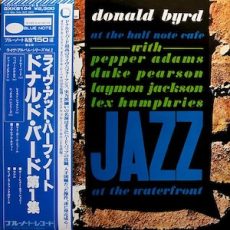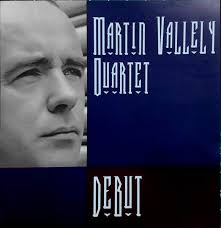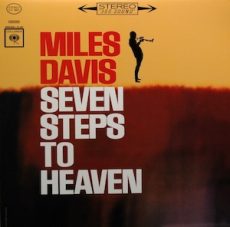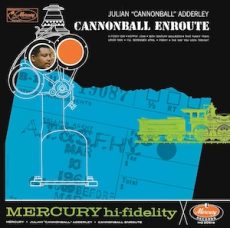
Requisites
Donald Byrd at The Half Note Café, Volume 1 | By Eddie Carter
I was still in the mood to hear another trumpet album after listening to Harry “Sweets” Edison when my search led me to another of my Mom’s favorite records. Donald Byrd and Pepper Adams were two musicians she enjoyed listening to and this morning’s record from the library brings them together in a great live date. Donald Byrd at The Half Note Café, Volume 1 (Blue Note BLP 4060/BST 84060) captures the trumpeter’s quintet featuring Pepper Adams (tracks: A1, A2, B2, B3) on baritone sax, Duke Pearson on piano, Laymon Jackson on bass and Lex Humphries on drums in performance at one of New York’s best jazz clubs. This album holds a special place in my heart because it reminds me of the music my Mom and I used to enjoy together during Sunday dinner. My copy is the 1978 King Record Company Japanese Stereo reissue (Blue Note BST 84060 – GXK-8104).
Ruth Mason is our Mistress of Ceremonies for the evening and starts the set with the musician’s introductions. The quintet then launches into the upbeat melody of My Girl Shirl by Duke Pearson. Donald kicks off the solos with an invigorating statement; then Pepper succeeds him with a joyfully spirited solo. Duke emerges next for a brisk presentation, and the front line cooks with Lex ahead of the close. Donald introduces the next tune, his own Soulful Kiddy, a blues that slows the beat down for the ensemble’s marching melody. Pepper serves up some down-home cooking in the opening solo. Donald comes into the second reading with carefree enthusiasm; then Duke eases into the spotlight last, leading to the theme’s restatement and climax.
Side Two opens with Donald’s introduction to A Portrait of Jennie by J. Russel Robinson and Gordon Burdge. The quartet showcase begins with the trumpeter’s romantically warm introduction to the melody. He continues mining a rich vein of sentimentality in the first solo. Duke takes over to deliver a very pretty reading until Donald’s return to add a few more comments into the reprise and close. Cecile by Donald Byrd brings the quintet back for a medium blues that commences with the trio’s introduction to the front line, taking the lead in the melody. Pepper takes off first, cruising at a comfortable pace. Donald gets to work next with an impressive interpretation, and then Duke completes the infectious beat in the finale ahead of the quintet’s closing moments.
The set climaxes with the group’s theme, Pure D. Funk. Donald has the showcase to himself in a concise theme and the song’s only solo into the ensemble’s conclusion. Alfred Lion produced Donald Byrd at The Half Note Café, Volume 1, and Rudy Van Gelder was behind the dials. The reissue has an excellent soundstage transporting the listener to the club audience with excellent fidelity. The unique sound of this album, with its stellar rhythm section and the great chemistry between Donald Byrd and Pepper Adams, is sure to captivate any jazz enthusiast. I invite you to pick up Donald Byrd at The Half Note Café, Volume 1, on your next record shopping trip. It’s a delightful live album that is sure to enjoy repeated plays on the turntable!
Postscript: For those who are unaware, Ruth Mason was a singer and WOV on-air personality who would become Mrs. Alfred Lion. She is also the lovely young woman who appears on the cover of Moods by The Three Sounds.
~ Moods (Blue Note BLP 4044/BST 84044) – Source: Discogs.com © 2024 by Edward Thomas CarterMore Posts: choice,classic,collectible,collector,history,instrumental,jazz,music,trumpet

Daily Dose Of Jazz…
Martin Vallely was born in Belfast, Ireland on July 1, 1962. His musical history spans a career working with Cork bands Soon and No Sangoma to working with acclaimed indie oufit Dear Wolf in Germany with whom he recorded.
As a bandleader he put together a quartet that recorded and released three albums beginning in 2008 with Debut, his maiden voyage receiving critical acclaim as a jazz composer. The following year Waltzin and in 2010 he released Gloves Off.
As a singer/songwriter, Martin also released two cds of his own songs as the band Glen River, first 12 in 2009 and After The Fall in 2010 which showcases his songwriting abilities. He is a half of an excellent duo called The Apologists.
Bassist, composer, songwriter, producer and educator Martin Vallely presently resides in Cork, Ireland where he continues to perform and teach.
More Posts: bass,bódhran,guitar,history,instrumental,jazz,music,saxophone

Requisites
Seven Steps To Heaven ~ Miles Davis | By Eddie Carter
This morning’s album from the library is a hidden gem in Miles Davis’s extensive discography. In 1962, his quintet was undergoing a significant transition. Hank Mobley departed to pursue a solo career, and the musical trio of Kelly, Chambers, and Cobb would soon become one of the most celebrated in jazz. Seven Steps To Heaven (Columbia CL 2051/CS 8851) is a product of two sessions by the trumpeter at Columbia’s New York and Los Angeles studios. His supporting cast includes George Coleman (tracks: A2, B1, B3) on tenor sax, Victor Feldman (A1, A3, B2), Herbie Hancock (A2, B1, B3) on piano, Ron Carter on bass, Frank Butler (A1, A3, B2), and Anthony Williams (A2, B1, B3) on drums. My copy is the original 1963 U.S. Stereo release.
Side One starts with Basin Street Blues by Spencer Williams. The first of three quartet performances opens with the foursome expressing the song’s softer emotions in the melody, featuring Miles using a mute. He sustains the gentle mood in the first solo before picking up the pace for a delightful conclusion. Victor gets into something good in a delightful reading ahead of the quartet, easing back into the theme. Seven Steps To Heaven by Miles Davis and Victor Feldman is off to the races from the rhythm section’s introduction to the quintet’s quick melody. Miles kicks off the solos, wailing, and then George swings vigorously into the second statement. Herbie takes an exhilarating turn next, preceding the reprise and close.
I Fall In Love Too Easily by Jule Styne and Sammy Cahn first appeared in the 1945 musical comedy Anchors Aweigh. Miles is back on the muted trumpet for the quartet’s tenderness and warmth during the melody. The leader’s opening statement is reflective yet quite beautiful. Victor expresses great care and thoughtfulness in the second solo until Miles returns to deliver a gorgeous climax. So Near, So Far by Tony Crombie and Benny Green kicks off the second side with the quintet’s medium theme. Miles gets things started on the open horn. George picks up the baton and really shines in the following presentation. Herbie has the final word and delivers a terrific performance into the ensemble regrouping for the closing chorus.
Baby, Won’t You Please Come Home by Charles Warfield and Clarence Williams is a blues song from 1919 that brings Miles back on the muted trumpet. Victor opens with a solo introduction ahead of the quartet’s touching melody. The trumpeter opens with a delicately tender interpretation; then Victor brings the solos to a close into the foursome’s thoughtfully graceful ending. Victor Feldman’s Joshua turns the temperature up one final time. Miles’s fingers snap the quintet to attention for the song’s lively theme. Miles steps up first in the spotlight with an enthusiastic performance. George takes over to deliver long, flowing lines that are equally satisfying. Herbie wraps things up with a festive finale that hits a perfect groove into the quintet’s reprise and completion.
Teo Macero produced Seven Steps To Heaven, although it’s unknown who recorded both sessions. It doesn’t matter, however, because this is a terrific recording with a crisp, detailed soundstage that sparkles. It is the first time George, Herbie, Ron, and Tony have recorded with Miles. George wouldn’t make another studio album with Miles, but appears on three live albums with this group, ‘Four’ & More, Miles Davis In Europe and My Funny Valentine. Hancock, Carter, and Williams formed the nucleus of Miles’s second great quintet and would remain with him for the next five years.
Victor turned down Miles’s invitation to join his quintet because he was a successful West Coast session musician, so he and Frank remained in California. If you’re in the mood for an excellent album of ballads and uptempo tunes and are a fan of Miles Davis from the early sixties, I highly recommend checking out Seven Steps To Heaven. It’s a stellar album that not only gives a glimpse into what was to come from The Second Great Miles Davis Quintet but also stands on its own as a title worthy of any jazz lover’s library. You’ll find it a rewarding addition to your collection, and I’m confident it will bring you hours of musical enjoyment.
~ ‘Four’ & More (Columbia CL 2453/CS 9253), Miles Davis In Europe (Columbia CL 2183/CS 8983), My Funny Valentine (Columbia CL 2306/CS 9106) – Source: Discogs.com ~ Baby, Won’t You Please Come Home, Basin Street Blues, I Fall In Love Too Easily – Source: JazzStandards.com © 2024 by Edward Thomas CarterMore Posts: choice,classic,collectible,collector,history,instrumental,jazz,music,trumpet

Daily Dose Of Jazz…
Takeshi Ogura was born on June 17, 1962 in Tokyo, Japan. He initially studied piano and trumpet before switching to the guitar. Moving to New York City at 26, he studied jazz guitar with be-bop guitar pioneer Chuck Wayne while attending The College of Staten Island in the Eighties. There he studied harmony and composition with Dr. Joseph Scianni. For ten years he was active on the New York jazz scene, then life caught up with him and he quit playing.
Takeshi got back to playing guitar in 2001 and has steadily built a reputation as a versatile and expressive player. Taking up residence in the Bronx, he often appears around the city with his jazz trio playing his compositions and unique arrangements of jazz standards. Since 2009 he regulary performs at The Bass Line in Mt. Vernon, New York.
He has shared stage performances with Duke Jones, Norman Connors, Sean Smith, Scott Fragala, Tyrone Govan, John Cooksey, John Fumasoli, James “Sugar Bear” Skelton, Jr., Art Bennett, Jasper Cain, Bill Crow, Seiji Ochiai, Dwayne Purdue, and Hiroshi Yamazaki.
Guitarist Takeshi Ogura, who has never led a recording session, continues to support this local and regional jazz scene with his trio and funk-jazz band New Project, along with Alan Eicher, Rondew Monroe and Greg Brown.
More Posts: bandleader,guitar,history,instrumental,jazz,music

Requisites
Cannonball Enroute ~ Julian “Cannonball” Adderley | By Eddie Carter
The weather outside was frightful because it was raining hard here in Atlanta. After the sun returned, it became a perfect time to hear the smooth alto sax of Julian “Cannonball” Adderley. He enters this morning’s spotlight with a 1961 album, Cannonball Enroute (Mercury Records MG 20616), backed by his quintet of Nat Adderley on cornet, Junior Mance on piano, Sam Jones on bass, and Jimmy Cobb on drums. My copy is the original U.S. Mono release. A Foggy Day by George and Ira Gershwin opens the album. The quintet starts at a medium beat, setting the stage for Cannonball’s lead solo. Nat picks up the pace in a muted reading until his brother returns to lead the ensemble out.
Hoppin’ John by Nat Adderley takes off with Junior’s speedy introduction ahead of the ensemble’s quick melody. Cannonball ignites the opening solo with a furious charge. Nat responds with plenty to say next. Junior follows with a rapid reading, and Jimmy shares the finale with the front line before the quintet makes a quick exit. 18th Century Ballroom by Nat Adderley and Ray Bryant begins with the ensemble’s pretty melody. Nat opens with a solo that’s quite compelling. Cannonball follows with a superb, articulate statement, then Junior gets the last word in an excellent reading leading back to the closing chorus and finale.
The group takes a trip aboard That Funky Train by Nat Adderley next. Sam and Jimmy get the train rolling with their introduction to the group’s theme. Sam has the first solo and walks with conviction. Junior is next with a very down-home presentation. Nat brings up the rear with a muted finale ahead of the reprise, and the rhythm section slowly dissolves into nothingness. Lover Man (Oh, Where Can You Be) by Jimmy Davis, Roger Ramirez and Jimmy Sherman starts Side Two with a solo showcase for Cannonball. The ensemble begins the introduction before the altoist steps in to deliver a tender melody and the song’s only statement until the group wraps it up.
I’ll Remember April by Don Raye, Gene De Paul, and Pat Johnson begins briskly with Jimmy’s introduction ahead of the quintet’s theme. Cannonball gets things going with a swift opening statement. Nat follows with a heated reading; then Junior takes over for a sparkling solo preceding the group’s return for the close. Porky by Cannonball and Nat Adderley is a fun tune that begins with the front line’s collective melody in a medium setting. Nat swings comfortably into the first interpretation; then Sam takes a relaxing turn in the following reading. Cannonball completes the solos with an attractive piece before the closing chorus ends with a Dixieland flavor.
The Way You Look Tonight by Dorothy Kern and Jerome Kern starts with Junior’s introduction to the quintet’s speedy melody. Cannonball surges into the lead solo like a whirlwind, and then Nat makes a blistering statement. Junior steps up next with an accelerated performance, and Jimmy engages in a brief exchange with both horns into the theme’s restatement and climax. It’s unknown who produced the session or who the recording engineer was, but the album’s sound quality is excellent with a clear soundstage.
Cannonball Enroute was Adderley’s fifth Mercury release and his third with this group. The quintet worked well as a cohesive unit but lasted only two years. He would return in 1959 with a new quintet after a brief time with Miles Davis that would become his most successful. If you’re a new or seasoned fan of Julian “Cannonball” Adderley and are in the mood for a wonderful hard bop album, I offer for your consideration, Cannonball Enroute on your next record shopping trip. It’s a great, if overlooked, album in his large discography that’s worth every penny for a spot in your library!
~ Cannonball’s Sharpshooters (Mercury Records MG 20531/SR 60208), Sophisticated Swing (EmArcy MG 36110) – Source: Discogs.com
~ A Foggy Day, I’ll Remember April, Lover Man (Oh, Where Can You Be), The Way You Look Tonight – Source: JazzStandards.com
© 2024 by Edward Thomas CarterMore Posts: choice,classic,collectible,collector,history,instrumental,jazz,music,saxophone



